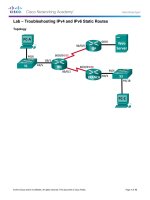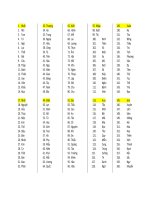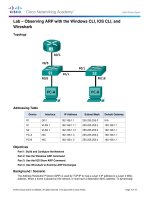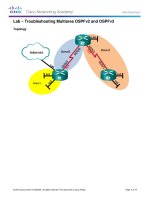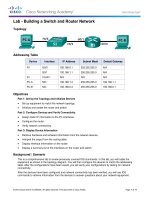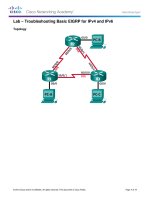CCIE routing and switching v5 0 official cert guide volume 1 kho tài liệu bách khoa
Bạn đang xem bản rút gọn của tài liệu. Xem và tải ngay bản đầy đủ của tài liệu tại đây (15.5 MB, 957 trang )
From the Library of Patriz Meulendijks
CCIE Routing and
Switching v5.0 Official
Cert Guide, Volume 1
Fifth Edition
Narbik Kocharians, CCIE No. 12410
Peter Palúch, CCIE No. 23527
Cisco Press
800 East 96th Street
Indianapolis, IN 46240
From the Library of Patriz Meulendijks
CCIE Routing and Switching v5.0 Official Cert Guide,
Volume 1, Fifth Edition
Narbik Kocharians, CCIE No. 12410
Peter Palúch, CCIE No. 23527
Copyright© 2015 Pearson Education, Inc.
Published by:
Cisco Press
800 East 96th Street
Indianapolis, IN 46240 USA
All rights reserved. No part of this book may be reproduced or transmitted in any form or by any means,
electronic or mechanical, including photocopying, recording, or by any information storage and retrieval
system, without written permission from the publisher, except for the inclusion of brief quotations in a
review.
Printed in the United States of America
First Printing August 2014
Library of Congress Control Number: 2014944345
ISBN-13: 978-1-58714-396-0
ISBN-10: 1-58714-396-8
Warning and Disclaimer
This book is designed to provide information about Cisco CCIE Routing and Switching Written Exam,
No. 400-101. Every effort has been made to make this book as complete and as accurate as possible, but
no warranty or fitness is implied.
The information is provided on an “as is” basis. The authors, Cisco Press, and Cisco Systems, Inc. shall
have neither liability nor responsibility to any person or entity with respect to any loss or damages arising
from the information contained in this book or from the use of the discs or programs that may accompany it.
The opinions expressed in this book belong to the authors and are not necessarily those of Cisco
Systems, Inc.
From the Library of Patriz Meulendijks
Trademark Acknowledgments
All terms mentioned in this book that are known to be trademarks or service marks have been appropriately capitalized. Cisco Press or Cisco Systems, Inc., cannot attest to the accuracy of this information.
Use of a term in this book should not be regarded as affecting the validity of any trademark or service
mark.
Special Sales
For information about buying this title in bulk quantities, or for special sales opportunities (which may
include electronic versions; custom cover designs; and content particular to your business, training
goals, marketing focus, or branding interests), please contact our corporate sales department at
or (800) 382-3419.
For government sales inquiries, please contact
For questions about sales outside the U.S., please contact
Feedback Information
At Cisco Press, our goal is to create in-depth technical books of the highest quality and value. Each book
is crafted with care and precision, undergoing rigorous development that involves the unique expertise of
members from the professional technical community.
Readers’ feedback is a natural continuation of this process. If you have any comments regarding how we
could improve the quality of this book, or otherwise alter it to better suit your needs, you can contact us
through email at Please make sure to include the book title and ISBN in your
message.
We greatly appreciate your assistance.
Publisher: Paul Boger
Copy Editor: John Edwards
Associate Publisher: Dave Dusthimer
Technical Editors: Paul Negron, Sean Wilkins
Business Operation Manager, Cisco Press:
Jan Cornelssen
Editorial Assistant: Vanessa Evans
Executive Editor: Brett Bartow
Managing Editor: Sandra Schroeder
Senior Development Editor:
Christopher Cleveland
Cover Designer: Mark Shirar
Composition: Tricia Bronkella
Indexer: Tim Wright
Proofreader: Chuck Hutchinson
Senior Project Editor: Tonya Simpson
From the Library of Patriz Meulendijks
iv
CCIE Routing and Switching v5.0 Official Cert Guide, Volume 1
About the Authors
Narbik Kocharians, CCIE No. 12410 (Routing and Switching, Security, SP), is a Triple
CCIE with more than 32 years of experience in the IT industry. He has designed,
implemented, and supported numerous enterprise networks. Narbik is the president of
Micronics Training Inc. (www.micronicstraining.com), where he teaches CCIE R&S and
SP boot camps.
Peter Palúch, CCIE No. 23527 (Routing and Switching), is an assistant professor, Cisco
Networking Academy instructor, and instructor trainer at the Faculty of Management
Science and Informatics, University of Zilina, Slovakia. Peter has cooperated in various
educational activities in Slovakia and abroad, focusing on networking and Linux-based
network server systems. He is also active at the Cisco Support Community, holding the
Cisco Designated VIP award in LAN & WAN Routing and Switching areas since the
award program inception in 2011. Upon invitation by Cisco in 2012, Peter joined two Job
Task Analysis groups that assisted defining the upcoming CCIE R&S and CCNP R&S certification exam topics. Peter holds an M.Sc. degree in Applied Informatics and a doctoral
degree in the area of VoIP quality degradation factors. Together with his students, Peter
has started the project of implementing the EIGRP routing protocol into the Quagga
open-source routing software suite, and has been driving the effort since its inception in
2013.
From the Library of Patriz Meulendijks
v
About the Technical Reviewers
Paul Negron, CCIE No. 14856, CCSI No. 22752, has been affiliated with networking
technologies for 17 years and has been involved with the design of core network services for a number of service providers, such as Comcast, Qwest, British Telecom, and
Savvis to name a few. He currently instructs all the CCNP Service Provider–level courses,
including Advanced BGP, MPLS, and the QoS course. Paul has six years of experience
with satellite communications as well as ten years of experience with Cisco platforms.
Sean Wilkins is an accomplished networking consultant for SR-W Consulting
(www.sr-wconsulting.com) and has been in the field of IT since the mid 1990s, working
with companies such as Cisco, Lucent, Verizon, and AT&T as well as several other private
companies. Sean currently holds certifications with Cisco (CCNP/CCDP), Microsoft
(MCSE), and CompTIA (A+ and Network+). He also has a Master of Science in information technology with a focus in network architecture and design, a Master of Science
in organizational management, a Master’s Certificate in network security, a Bachelor of
Science in computer networking, and Associates of Applied Science in computer information systems. In addition to working as a consultant, Sean spends most of his time as a
technical writer and editor for various companies; check out this work at his author website: www.infodispersion.com.
From the Library of Patriz Meulendijks
vi
CCIE Routing and Switching v5.0 Official Cert Guide, Volume 1
Dedications
From Narbik Kocharians:
I would like to dedicate this book to my wife, Janet, for her love, encouragement, and
continuous support, and to my dad for his words of wisdom.
From Peter Palúch:
To my family, students, colleagues, and friends.
From the Library of Patriz Meulendijks
vii
Acknowledgments
From Narbik Kocharians:
First, I would like to thank God for giving me the opportunity and ability to write, teach,
and do what I truly enjoy doing. Also, I would like to thank my family, especially my
wife of 29 years, Janet, for her constant encouragement and help. She does such an amazing job of interacting with students and handling all the logistics of organizing classes as
I focus on teaching. I also would like to thank my children, Chris, Patrick, Alexandra, and
my little one, Daniel, for their patience.
A special thanks goes to Mr. Brett Bartow for his patience and our constant changing
of the deadlines. It goes without saying that the technical editors and reviewers did a
phenomenal job; thank you very much. Finally, I would like to thank all my students who
inspire me every day, and you, for reading this book.
From Peter Palúch:
The opportunity to cooperate on the new edition of this book has been an honor and
privilege beyond words for me. Wendell Odom, who has so gracefully and generously
passed the torch to us, was the key person in introducing me to the Cisco Press representatives as a possible author, and I will be forever indebted to him for all the trust he
has blessed us with. I have strived very much to live up to the unparalelled high level of
content all previous authors have maintained throughout all editions of this book, and I
would like to sincerely thank all of them for authoring such a great book that has significantly helped me achieve my certification in the first place.
My next immense thank you goes to Brett Bartow, the executive editor for this book.
Brett’s inviting and forthcoming attitude throughout the time of editing the book, compounded with his patience and understanding for my ever-moving (and constantly missed)
deadlines, is second to none. He has done all in his power to help us, the authors, without
compromising the quality of the work.
I would not have been able to complete my work on this volume without the endless support of my family. They have encouraged me, supported me, and gone out of their way to
accommodate my needs. Words are not enough to express my gratitude.
Psalm 127, whose musical setting in works of Monteverdi, Handel, or Vivaldi I have
come to admire, begins with words “Unless the Lord build the house, they labor in vain
who build.” Indeed, if it was not first and foremost the Lord’s blessing and help throughout, this work would not have been finished successfully. To my Lord and Savior, Jesus
Christ—thank you!
From the Library of Patriz Meulendijks
viii
CCIE Routing and Switching v5.0 Official Cert Guide, Volume 1
Contents at a Glance
Introduction
xxiv
Part I
LAN Switching
Chapter 1
Ethernet Basics
Chapter 2
Virtual LANs and VLAN Trunking
Chapter 3
Spanning Tree Protocol
Part II
IP Networking
Chapter 4
IP Addressing
Chapter 5
IP Services
Part III
IP IGP Routing
Chapter 6
IP Forwarding (Routing)
Chapter 7
RIPv2 and RIPng
Chapter 8
EIGRP
347
Chapter 9
OSPF
453
Chapter 10
IS-IS
Chapter 11
IGP Route Redistribution, Route Summarization, Default Routing, and
Troubleshooting 633
Part IV
Final Preparation
Chapter 12
Final Preparation
Part V
Appendixes
Appendix A
Answers to the “Do I Know This Already?” Quizzes 707
Appendix B
CCIE Exam Updates
3
47
103
183
227
267
313
563
701
713
Index 714
CD-Only
Appendix C
Decimal to Binary Conversion Table
Appendix D
IP Addressing Practice
Appendix E
Key Tables for CCIE Study
Appendix F
Solutions for Key Tables for CCIE Study
Appendix G
Study Planner
Glossary
From the Library of Patriz Meulendijks
ix
Contents
Introduction
xxiv
Part I
LAN Switching
Chapter 1
Ethernet Basics
3
“Do I Know This Already?” Quiz
Foundation Topics
3
8
Ethernet Layer 1: Wiring, Speed, and Duplex
RJ-45 Pinouts and Category 5 Wiring
Autonegotiation, Speed, and Duplex
CSMA/CD
8
8
9
10
Collision Domains and Switch Buffering
Basic Switch Port Configuration
Ethernet Layer 2: Framing and Addressing
Types of Ethernet Addresses
Ethernet Address Formats
10
11
14
16
17
Protocol Types and the 802.3 Length Field
Switching and Bridging Logic
18
19
SPAN, RSPAN, and ERSPAN
22
Core Concepts of SPAN, RSPAN, and ERSPAN
Restrictions and Conditions
Basic SPAN Configuration
26
Complex SPAN Configuration
RSPAN Configuration
26
26
ERSPAN Configuration
Virtual Switch System
27
28
Virtual Switching System
29
VSS Active and VSS Standby Switch
Virtual Switch Link
30
30
Multichassis EtherChannel (MEC)
Basic VSS Configuration
31
31
VSS Verification Procedures
IOS-XE
23
24
35
38
Foundation Summary
41
From the Library of Patriz Meulendijks
x
CCIE Routing and Switching v5.0 Official Cert Guide, Volume 1
Memory Builders
44
Fill In Key Tables from Memory
Definitions
44
44
Further Reading 45
Chapter 2
Virtual LANs and VLAN Trunking
“Do I Know This Already?” Quiz
Foundation Topics
Virtual LANs
47
47
51
51
VLAN Configuration
51
Using VLAN Database Mode to Create VLANs
52
Using Configuration Mode to Put Interfaces into VLANs
Using Configuration Mode to Create VLANs
Modifying the Operational State of VLANs
Private VLANs
55
56
57
60
VLAN Trunking: ISL and 802.1Q
ISL and 802.1Q Concepts
69
69
ISL and 802.1Q Configuration
71
Allowed, Active, and Pruned VLANs 76
Trunk Configuration Compatibility 76
Configuring Trunking on Routers
802.1Q-in-Q Tunneling
79
VLAN Trunking Protocol
83
77
VTP Process and Revision Numbers
VTP Configuration
86
89
Normal-Range and Extended-Range VLANs
Storing VLAN Configuration
94
94
Configuring PPPoE 96
Foundation Summary
Memory Builders
99
101
Fill In Key Tables from Memory
Definitions
101
101
Further Reading 101
From the Library of Patriz Meulendijks
xi
Chapter 3
Spanning Tree Protocol
103
“Do I Know This Already?” Quiz
Foundation Topics
103
107
802.1D Spanning Tree Protocol and Improvements
107
Choosing Which Ports Forward: Choosing Root Ports and Designated
Ports 109
Electing a Root Switch
110
Determining the Root Port
111
Determining the Designated Port
113
Converging to a New STP Topology
115
Topology Change Notification and Updating the CAM
Transitioning from Blocking to Forwarding
119
Per-VLAN Spanning Tree and STP over Trunks
119
STP Configuration and Analysis
Rapid Spanning Tree Protocol
124
128
New Port Roles, States and Types, and New Link Types
Changes to BPDU Format and Handling
Proposal/Agreement Process in RSTP
Topology Change Handling in RSTP
MST Principles of Operation
128
132
133
136
Rapid Per-VLAN Spanning Tree Plus (RPVST+)
Multiple Spanning Trees: IEEE 802.1s
137
137
138
Interoperability Between MST and Other STP Versions
MST Configuration
141
144
Protecting and Optimizing STP
PortFast Ports
117
148
148
Root Guard, BPDU Guard, and BPDU Filter: Protecting Access Ports
Protecting Against Unidirectional Link Issues
151
Configuring and Troubleshooting EtherChannels
154
Load Balancing Across Port-Channels
154
Port-Channel Discovery and Configuration
Troubleshooting Complex Layer 2 Issues
Layer 2 Troubleshooting Process
149
157
161
162
Layer 2 Protocol Troubleshooting and Commands
Troubleshooting Using Cisco Discovery Protocol
163
163
Troubleshooting Using Link Layer Discovery Protocol
Troubleshooting Using Basic Interface Statistics
165
167
From the Library of Patriz Meulendijks
xii
CCIE Routing and Switching v5.0 Official Cert Guide, Volume 1
Troubleshooting Spanning Tree Protocol
Troubleshooting Trunking
Troubleshooting VTP
171
172
Troubleshooting EtherChannels
174
Approaches to Resolving Layer 2 Issues
Foundation Summary
Memory Builders
175
177
179
Fill in Key Tables from Memory
Definitions
170
179
179
Further Reading 179
Part II
IP Networking
Chapter 4
IP Addressing
183
“Do I Know This Already?” Quiz
Foundation Topics
IP Operation
183
187
187
TCP Operation
187
UDP Operation
188
IP Addressing and Subnetting
188
IP Addressing and Subnetting Review
188
Subnetting a Classful Network Number
Comments on Classless Addressing
Subnetting Math
189
191
192
Dissecting the Component Parts of an IP Address
192
Finding Subnet Numbers and Valid Range of IP Addresses—
Binary 193
Decimal Shortcuts to Find the Subnet Number and Valid Range of IP
Addresses 194
Determining All Subnets of a Network—Binary
196
Determining All Subnets of a Network—Decimal
VLSM Subnet Allocation
198
200
Route Summarization Concepts
201
Finding Inclusive Summary Routes—Binary
202
Finding Inclusive Summary Routes—Decimal
203
Finding Exclusive Summary Routes—Binary
204
CIDR, Private Addresses, and NAT 205
Classless Interdomain Routing 206
Private Addressing 207
From the Library of Patriz Meulendijks
xiii
Network Address Translation
Static NAT
207
209
Dynamic NAT Without PAT
210
Overloading NAT with Port Address Translation
Dynamic NAT and PAT Configuration
IPv6
212
214
IPv6 Address Format
Network Prefix
215
215
IPv6 Address Types
216
Address Management and Assignment
Static Configuration
Stateful DHCPv6
218
IPv6 Transition Technologies
Dual Stack
218
Tunneling
219
218
220
Foundation Summary
Memory Builders
221
225
Fill in Key Tables from Memory
Definitions
225
225
Further Reading
IP Services
217
217
Stateless DHCP
Translation
216
217
Stateless Address Autoconfiguration
Chapter 5
225
227
“Do I Know This Already?” Quiz
Foundation Topics
227
232
ARP, Proxy ARP, Reverse ARP, BOOTP, and DHCP
ARP and Proxy ARP
DHCP
232
232
RARP, BOOTP, and DHCP
233
234
HSRP, VRRP, and GLBP
236
Network Time Protocol
240
SNMP
211
241
SNMP Protocol Messages
243
SNMP MIBs 244
SNMP Security
Syslog
245
245
From the Library of Patriz Meulendijks
xiv
CCIE Routing and Switching v5.0 Official Cert Guide, Volume 1
Web Cache Communication Protocol
246
Implementing the Cisco IOS IP Service Level Agreement (IP SLA)
Feature 249
Implementing NetFlow
250
Implementing Router IP Traffic Export
252
Implementing Cisco IOS Embedded Event Manager
Implementing Remote Monitoring
254
Implementing and Using FTP on a Router
255
Implementing a TFTP Server on a Router
256
Implementing Secure Copy Protocol
257
Implementing HTTP and HTTPS Access
Implementing Telnet Access
Implementing SSH Access
Foundation Summary
Memory Builders
257
258
258
259
264
Fill In Key Tables from Memory
Definitions
253
264
264
Further Reading 264
Part III
IP IGP Routing
Chapter 6
IP Forwarding (Routing)
267
“Do I Know This Already?” Quiz
Foundation Topics
IP Forwarding
267
271
271
Process Switching, Fast Switching, and Cisco Express Forwarding
Load Sharing with CEF and Related Issues
272
282
Multilayer Switching 286
MLS Logic
286
Using Routed Ports and Port-channels with MLS
MLS Configuration
Policy Routing
287
291
296
Routing Protocol Changes and Migration
Planning the Migration Strategy
299
300
Activating New IGP While Keeping the Current IGP Intact
300
Verifying New IGP Adjacencies and Working Database Contents
Deactivating Current IGP
301
301
Removing New IGP’s Temporary Settings
303
Specifics of Distance-Vector Protocols in IGP Migration
303
From the Library of Patriz Meulendijks
xv
Foundation Summary
Memory Builders
309
310
Fill In Key Tables from Memory
Definitions
Chapter 7
Further Reading
310
RIPv2 and RIPng
313
“Do I Know This Already?” Quiz
Foundation Topics
313
316
Introduction to Dynamic Routing
RIPv2 Basics
310
310
316
318
RIPv2 Convergence and Loop Prevention
Converged Steady-State Operation
320
327
Triggered (Flash) Updates and Poisoned Routes
328
RIPv2 Convergence When Routing Updates Cease
Convergence Extras
RIPv2 Configuration
331
334
334
Enabling RIPv2 and the Effects of Autosummarization
RIPv2 Authentication
337
RIPv2 Next-Hop Feature and Split Horizon
RIPv2 Offset Lists
338
338
Route Filtering with Distribute Lists and Prefix Lists
RIPng for IPv6
Memory Builders
EIGRP
342
345
345
Further Reading
Chapter 8
338
339
Foundation Summary
Definitions
335
345
347
“Do I Know This Already?” Quiz
Foundation Topics
347
356
EIGRP Basics and Evolution
356
EIGRP Roots: Interior Gateway Routing Protocol
Moving from IGRP to Enhanced IGRP
358
EIGRP Metrics, Packets, and Adjacencies
360
EIGRP Classic Metrics
357
360
Bandwidth Metric Component
Delay Metric Component
361
361
From the Library of Patriz Meulendijks
xvi
CCIE Routing and Switching v5.0 Official Cert Guide, Volume 1
Reliability Metric Component 362
Load Metric Component
362
MTU Metric Component
363
Hop Count Metric Component
363
Calculating the Composite Metric
EIGRP Wide Metrics
363
364
Tweaking Interface Metrics to Influence Path Selection
EIGRP Packet Format
EIGRP Packets
368
368
371
EIGRP Packets in Action
Hello Packets
371
372
Acknowledgment Packets
Update Packets
372
373
Query Packet
374
Reply Packets
374
SIA-Query and SIA-Reply Packets
Reliable Transport Protocol
Router Adjacencies
374
376
Diffusing Update Algorithm
Topology Table
374
380
380
Computed, Reported, and Feasible Distances, and Feasibility
Condition 384
Local and Diffusing Computations in EIGRP
DUAL FSM
397
Stuck-In-Active State
EIGRP Named Mode
402
410
Address Family Section
414
Per-AF-Interface Configuration Section
Per-AF-Topology Configuration Section
Additional and Advanced EIGRP Features
Router ID
391
415
416
417
417
Unequal-Cost Load Balancing
Add-Path Support
Stub Routing
420
421
423
Route Summarization
Passive Interfaces
Graceful Shutdown
427
431
432
From the Library of Patriz Meulendijks
xvii
Securing EIGRP with Authentication
Default Routing Using EIGRP
Split Horizon
432
435
436
EIGRP Over the ToP
437
EIGRP Logging and Reporting
EIGRP Route Filtering
EIGRP Offset Lists
443
443
444
Clearing the IP Routing Table
Foundation Summary
444
445
Memory Builders 450
Fill In Key Tables from Memory
Definitions
Further Reading
Chapter 9
OSPF
450
450
450
453
“Do I Know This Already?” Quiz
Foundation Topics
460
OSPF Database Exchange
OSPF Router IDs
453
460
460
Becoming Neighbors, Exchanging Databases, and Becoming Adjacent
OSPF Neighbor States
462
Becoming Neighbors: The Hello Process
464
Transmitting LSA Headers to Neighbors
466
Database Description Exchange: Master/Slave Relationship
Requesting, Getting, and Acknowledging LSAs
Designated Routers on LANs
466
468
469
Designated Router Optimization on LANs
DR Election on LANs
470
471
Designated Routers on WANs and OSPF Network Types
472
Caveats Regarding OSPF Network Types over NBMA Networks
Example of OSPF Network Types and NBMA
SPF Calculation
474
474
479
Steady-State Operation
480
OSPF Design and LSAs
480
OSPF Design Terms
480
OSPF Path Selection Process
LSA Types
461
482
482
LSA Types 1 and 2
484
LSA Type 3 and Inter-Area Costs
488
From the Library of Patriz Meulendijks
xviii
CCIE Routing and Switching v5.0 Official Cert Guide, Volume 1
LSA Types 4 and 5, and External Route Types 1 and 2
OSPF Design in Light of LSA Types
Stubby Areas
496
496
OSPF Path Choices That Do Not Use Cost
Choosing the Best Type of Path
502
502
Best-Path Side Effects of ABR Loop Prevention
OSPF Configuration
502
505
OSPF Costs and Clearing the OSPF Process
507
Alternatives to the OSPF network Command
OSPF Filtering
492
510
510
Filtering Routes Using the distribute-list Command
OSPF ABR LSA Type 3 Filtering
511
513
Filtering Type 3 LSAs with the area range Command
Virtual Link Configuration
514
515
Configuring Classic OSPF Authentication
517
Configuring Extended Cryptographic OSPF Authentication
Protecting OSPF Routers with TTL Security Check
Tuning OSPF Performance
522
523
Tuning the SPF Scheduling with SPF Throttling
Tuning the LSA Origination with LSA Throttling
Incremental SPF
520
524
526
527
OSPFv2 Prefix Suppression 528
OSPF Stub Router Configuration
OSPF Graceful Restart
529
530
OSPF Graceful Shutdown
532
OSPFv3 533
Differences Between OSPFv2 and OSPFv3
533
Virtual Links, Address Summarization, and Other OSPFv3 Features
OSPFv3 LSA Types
534
OSPFv3 in NBMA Networks
536
Configuring OSPFv3 over Frame Relay
Enabling and Configuring OSPFv3
OSPFv3 Address Family Support
OSPFv3 Prefix Suppression
552
OSPFv3 Graceful Shutdown
552
537
537
OSPFv3 Authentication and Encryption
Foundation Summary
534
546
548
553
From the Library of Patriz Meulendijks
xix
Memory Builders 560
Fill in Key Tables from Memory 560
Definitions 560
Further Reading 561
Chapter 10
IS-IS
563
“Do I Know This Already?” Quiz
Foundation Topics
563
571
OSI Network Layer and Addressing
572
Levels of Routing in OSI Networks
576
IS-IS Metrics, Levels, and Adjacencies
IS-IS Packet Types
Hello Packets
577
579
579
Link State PDUs
580
Complete and Partial Sequence Numbers PDUs
IS-IS Operation over Different Network Types
IS-IS Operation over Point-to-Point Links
IS-IS Operation over Broadcast Links
Areas in IS-IS
IPv6 Support in IS-IS
Configuring IS-IS
587
592
Memory Builders
608
610
613
Foundation Summary
625
629
Fill In Key Tables from Memory
630
630
Further Reading
Chapter 11
586
598
Authentication in IS-IS
Definitions
585
630
IGP Route Redistribution, Route Summarization, Default Routing, and
Troubleshooting 633
“Do I Know This Already?” Quiz
Foundation Topics
633
638
Route Maps, Prefix Lists, and Administrative Distance
638
Configuring Route Maps with the route-map Command
638
Route Map match Commands for Route Redistribution
Route Map set Commands for Route Redistribution
IP Prefix Lists
640
641
641
Administrative Distance
644
From the Library of Patriz Meulendijks
xx
CCIE Routing and Switching v5.0 Official Cert Guide, Volume 1
Route Redistribution 645
Mechanics of the redistribute Command
Redistribution Using Default Settings
645
646
Setting Metrics, Metric Types, and Tags
649
Redistributing a Subset of Routes Using a Route Map
Mutual Redistribution at Multiple Routers
650
654
Preventing Suboptimal Routes by Setting the Administrative
Distance 656
Preventing Suboptimal Routes by Using Route Tags
659
Using Metrics and Metric Types to Influence Redistributed Routes
Route Summarization
663
EIGRP Route Summarization
OSPF Route Summarization
Default Routes
661
664
665
665
Using Static Routes to 0.0.0.0, with redistribute static
Using the default-information originate Command
Using the ip default-network Command
669
670
Using Route Summarization to Create Default Routes
Performance Routing (PfR)
Performance Routing Concepts
673
674
674
Performance Routing Operational Roles
Master Controller (MC)
Border Router
671
672
Performance Routing Operational Phases
Authentication
667
675
675
676
PfR Basic Configuration
677
Configuration of the Master Controller
Configuration of the Border Router
Task Completion on R3
677
681
682
Troubleshooting Complex Layer 3 Issues
Layer 3 Troubleshooting Process
683
684
Layer 3 Protocol Troubleshooting and Commands
IP Routing Processes
Approaches to Resolving Layer 3 Issues
Foundation Summary
686
686
695
696
From the Library of Patriz Meulendijks
xxi
Memory Builders
698
Fill In Key Tables from Memory
Definitions
698
698
Further Reading
Part IV
Final Preparation
Chapter 12
Final Preparation
698
701
Tools for Final Preparation
701
Pearson Cert Practice Test Engine and Questions on the CD
Install the Software from the CD
701
Activate and Download the Practice Exam
Activating Other Exams
Premium Edition
703
703
703
Chapter-Ending Review Tools
704
Suggested Plan for Final Review/Study
Using the Exam Engine
Summary
702
702
The Cisco Learning Network
Memory Tables
701
704
704
705
Part V
Appendixes
Appendix A
Answers to the “Do I Know This Already?” Quizzes
Appendix B
CCIE Exam Updates
707
713
Index 714
CD-Only
Appendix C
Decimal to Binary Conversion Table
Appendix D
IP Addressing Practice
Appendix E
Key Tables for CCIE Study
Appendix F
Solutions for Key Tables for CCIE Study
Appendix G
Study Planner
Glossary
From the Library of Patriz Meulendijks
xxii
CCIE Routing and Switching v5.0 Official Cert Guide, Volume 1
Icons Used in This Book
Communication
Server
PC
PC with
Software
Sun
Workstation
Macintosh
Branch
Office
Headquarters
Terminal
File
Server
Web
Server
Cisco Works
Workstation
House, Regular
Printer
Gateway
Laptop
Router
Label Switch
Router
IBM
Mainframe
Bridge
Cluster
Controller
ATM router
Hub
Cisco
MDS 9500
Catalyst
Switch
Multilayer
Switch
ATM
Switch
Route/Switch
Processor
LAN2LAN
Switch
Cisco
MDS 9500
Optical
Services
Router
Enterprise
Fibre Channel disk
Fibre
Channel
JBOD
ONS 15540
Network Cloud
Line: Ethernet
Line: Serial
Line: Switched Serial
From the Library of Patriz Meulendijks
xxiii
Command Syntax Conventions
The conventions used to present command syntax in this book are the same conventions used in the IOS
Command Reference. The Command Reference describes these conventions as follows:
■
Boldface indicates commands and keywords that are entered literally as shown. In
actual configuration examples and output (not general command syntax), boldface
indicates commands that are manually input by the user (such as a show command).
■
Italic indicates arguments for which you supply actual values.
■
Vertical bars (|) separate alternative, mutually exclusive elements.
■
Square brackets ([ ]) indicate an optional element.
■
Braces ({ }) indicate a required choice.
■
Braces within brackets ([{ }]) indicate a required choice within an optional element.
From the Library of Patriz Meulendijks
xxiv
CCIE Routing and Switching v5.0 Official Cert Guide, Volume 1
Introduction
The Cisco Certified Internetwork Expert (CCIE) certification might be the most challenging and prestigious of all networking certifications. It has received numerous awards
and certainly has built a reputation as one of the most difficult certifications to earn in
all of the technology world. Having a CCIE certification opens doors professionally and
typically results in higher pay and looks great on a resume.
Cisco currently offers several CCIE certifications. This book covers the version 5.0 exam
blueprint topics of the written exam for the CCIE Routing and Switching certification.
The following list details the currently available CCIE certifications at the time of this
book’s publication; check www.cisco.com/go/ccie for the latest information. The certifications are listed in the order in which they appear on the web page:
■
CCDE
■
CCIE Collaboration
■
CCIE Data Center
■
CCIE Routing & Switching
■
CCIE Security
■
CCIE Service Provider
■
CCIE Service Provider Operations
■
CCIE Wireless
Each of the CCDE and CCIE certifications requires the candidate to pass both a written
exam and a one-day, hands-on lab exam. The written exam is intended to test your knowledge of theory, protocols, and configuration concepts that follow good design practices.
The lab exam proves that you can configure and troubleshoot actual gear.
Why Should I Take the CCIE Routing and Switching Written Exam?
The first and most obvious reason to take the CCIE Routing and Switching written exam
is that it is the first step toward obtaining the CCIE Routing and Switching certification.
Also, you cannot schedule a CCIE lab exam until you pass the corresponding written
exam. In short, if you want all the professional benefits of a CCIE Routing and Switching
certification, you start by passing the written exam.
The benefits of getting a CCIE certification are varied and include the following:
■
Better pay
■
Career-advancement opportunities
From the Library of Patriz Meulendijks



